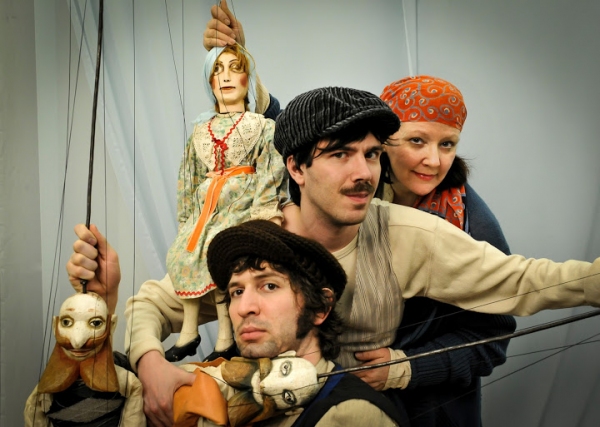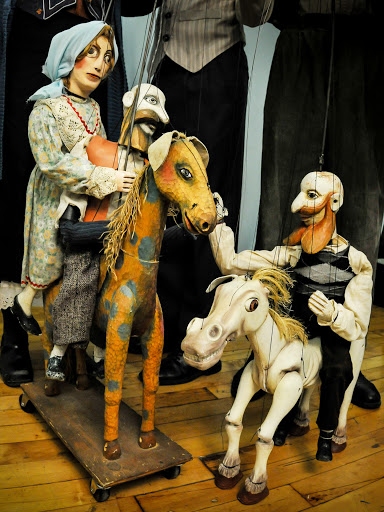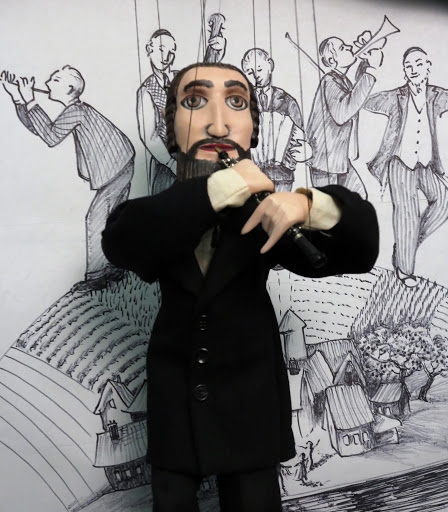Photo Flash: First Look at Czechoslovak-American Marionette Theatre's KING EXECUTIONER at TNC
The novel, which has never been published in English, is an allegorical tale of Polish peasant life in the early days of World War II. The book unfolds like a 20th century folk tale, narrating a farm boy's bumpy journey to manhood. The boy goes to fight with the partisans after the German invasion and his patriotic duty compels him to kill two neighbors he's known all his life. As he faces decisions about life and death for others, his story becomes a parable on the complex truths of existence and dignity. Music is composed by Frank London of The Klezmatics.
The tale begins in a small village in pre-World War II Poland, where two friends, Piotr and Jasiek, sing songs, steal apples, chickens, and horses; and court the two "most beautiful" maidens in the village, Marysia and Hela. Then, despite all merriment, Jasiek blows his brains out. The war comes. Piotr and his Jewish musician friend Moses are called to arms. The two friends witness first-hand the swift defeat of the Polish cavalry by German armored divisions, then return home. Moses hides out from the Nazis in the forest while Piotr, powerless to stop the destruction of Moses's shtetl, is restless in his farm work. Troubled by recurrent visions of dead Jewish musicians marching across the skies, he tries to drown his anguish with romance, but is torn between the two maidens he now woos alone. Eventually, Piotr finds his way into the resistance and becomes the executioner of two "traitors"--the postman and the police commandant. Every partisan death sentence is potentially a revenge: the boy who imagined himself a King becomes an executioner. Piotr is on the verge of suicide, tormenting his mother and his two lovers with his fixation on death. Finally Hela's pregnancy soothes Piotr's wounds and brings peace to his mind.
This performance will mix actor-puppeteers, marionettes and live onstage musicians. Seven performers will play multiple characters and interact with puppets of many sizes and styles, including traditional Czech marionettes, toy marionettes, shadow puppets and oversize puppets. In his unique hybrid staging method, Horejš conceives each character as a double--live performer and puppet--with inner dialogues being revealed amid several levels of subtext. These doubling techniques, which Horejs has been perfecting over twenty years, provide an onstage counterpoint to the characters and afford a heightened awareness of their personalities. Characters and puppets shadow each other, comment on the general action and sometimes blur the boundary of who is in control. Differing puppet sizes are used to create cinematic effects: close-ups, long shots and zooms.
The play will be staged before three "crankies," scrolling backgrounds of different sizes, all painted by Theresa Linnihan, rendered in black and white and lit in amber to suggest old sepia photographs. Puppets will climb on their wooden frames, sit on them, dance, and make love on them. The puppets range in size from eight inches to twelve feet. The miniature ones--representing resistance fighters, policemen and bystanders--are by Milos Kasal and are cast using molds from the 1920s. The principal characters are portrayed by 28" wooden marionettes designed and carved by Jakub Krejci (http://kuba.cz/en/artist) in his Prague workshop. One giant puppet is by Theresa Linnihan. There are about 20 puppets in all.
The score by Frank London was commissioned through the NYSCA individual artists composer commission for theater. He is a long-time collaborator of Horejš and previously scored CAMT's "Golem" and "Once There Was a Village." Set and costumes are designed Theresa Linnihan. Lighting is designed by Federico Restrepo.
The actor/puppeteers are Michelle Beshaw, Deborah Farrel Beshaw, John Farelle Beshaw, Joseph Garner, Miles Jackson, Theresa Linnihan and Christopher Scheer. The musicians are Jason Candler (clarinet), Nick Gianni (bass) and Hannah Temple (accordion).
Vit Horejš, an emigré from Prague, founded Czechoslovak-American Marionette Theatre (CAMT) in 1990, utilizing century-old Czech puppets which he found at Jan Hus Church on East 74th Street. His trademark is using puppets of many sizes, from six-inch toy marionettes to twelve-foot rod puppets which double as scenery. CAMT is dedicated to preserving and presenting traditional and not-so-traditional puppetry. Horejš is a proud recipient of New York Foundation for the Arts 2012-13 fellowship.
Theater for the New City has presented the company in three previous productions. "Mr. M" (2011) was the first American stage adaptation of "Mr. Theodore Mundstock" by Ladislav Fuks, a postwar Czech writer of psychological fiction. "Revolution!?" (2010) was performed with AGENTURA DELL'ARTE (from Prague); it was a theater spectacle that examined revolutions throughout the history of mankind as a backdrop for the extraordinary peaceful 1989 Velvet Revolution in former Czechoslovakia. "The Very Sad Story of Ethel & Julius, Lovers and Spyes..." (2008) explored the Rosenberg trial with a manipulated set but few puppets. Anita Gates wrote in the New York Times, "Vit Horejš has written and directed a first-rate, thoroughly original production and made it look effortless. The cast gives charged, cohesive performances, and the staging is expert." Horejš writes that he is excited to return to Crystal Field's theater, a venue which embraces new work and enables performances in innovative styles, like "King Executioner," to reach receptive audiences at affordable prices.
At La Mama E.T.C., the company has performed "The Little Rivermaid Rusalka" (1999), "Johannes Dokchtor Faust" (2000), "The Prose of the Transsiberian and of the Little Joan of France" (2001), "Don Juan or the Wages of Debauchery" (2003), "The Life and Times of Lee Harvey Oswald" (2004), "Once There Was a Village" (2007), an ethno-opera with puppets, found objects and music by Frank London; "Twelfth Night (or What You Will)" (2009) and the troupe's most successful work, "Golem" (1997, 1998 Henson International Puppetry Festival, and 2011), which also had a score by Frank London.
Productions in other venues have ranged from Czech classics to Shakespeare to fairy tales. "Johannes Dokchtor Faust" premiered in its first season (1990) and was re-staged in 1994 as part of NADA's Obie Award-winning "Faust Festival" in Soho. It was revived at La MaMa in 2000 and at Manhattan's Bohemian Hall in 2007. "Hamlet" debuted at the Vineyard Theater in 1995, was performed at outdoor venues in NY, and toured to the 2004 Prague Summer Shakespeare Festival at Prague Castle. It was revived on Jane's Carousel in DUMBO, Brooklyn in 2007. "The Bass Saxophone," a WWII fantasy with music based on a story by Czech-Canadian writer Josef Skvorecky, played 11 weeks at the Grand Army Plaza Soldiers' and Sailors' Memorial Arch in Brooklyn during the fall of 2005 and the spring of 2006. CAMT's productions for young audiences include "A Christmas Carol--OY! Hanukkah--Merry Kwanzaa," "The Historye of Queen Esther, of King Ahasverus & of the Haughty Haman," "Kacha and the Devil," "The White Doe - Or The Piteous Trybulations of the Sufferyng Countess Jenovefa," "Snehurka, The Snow Maiden" and "Twelve Iron Sandals."
CAMT has also appeared at the Metropolitan Museum of Art, Lincoln Center Out-of-Doors, the Winter Garden of the World Financial Center, the Smithsonian Institution, The World Trade Center, the Antonin Dvorak Festival in Spillville, Iowa, the 2012 inauguration of The National Czech and Slovak Museum and Library in Cedar Rapids, Iowa, the Heart of the Beast in Minneapolis, the Lowell Folk Arts Festival in Massachusetts and in international festivals in Poland, Turkey, Pakistan, and the Czech Republic.
Photos by Lee Wexler/Images for Innovation (unless otherwise specified).

Deborah Beshaw as Hela, Christopher Scheer as Piotr, Marionettes by Jakub "Kuba" Krejci.

Piotr and Stach arm wrestle. Christopher Scheer as Piotr, Miles Jackson as Stach, Marionettes by Jakub "Kuba" Krejci.

Front to back: Christopher Scheer (as Piotr), Joseph Garner (as Yasiek), Michelle Beshaw (as The Widow).

The Widow, Yasiek, and Piotr. Marionettes by Vaclav Krcal and Jakub "Kuba" Krejci.

Moses the clarinet player. Marionette by Vaclav Krcal. Photo by Jonathan Slaff.

Videos
